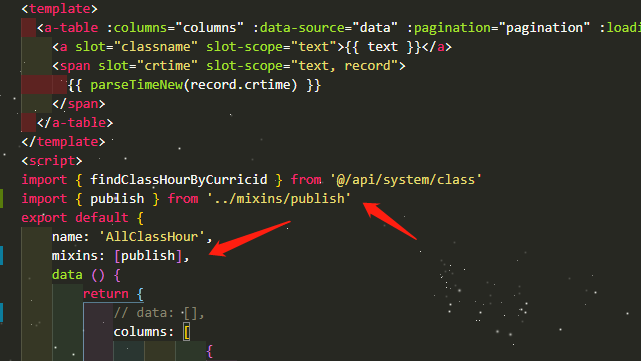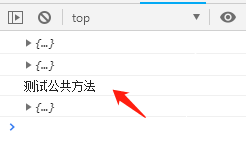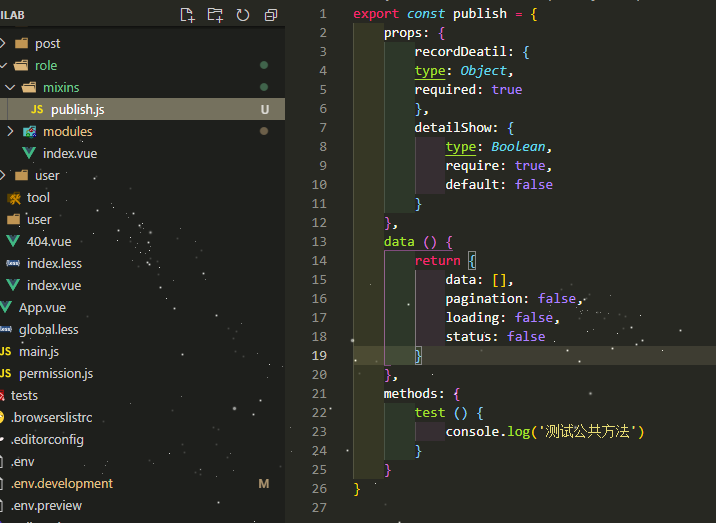vue之mixin理解与使用
使用场景
当有两个非常相似的组件,除了一些个别的异步请求外其余的配置都一样,甚至父组件传的值也是一样的,但他们之间又存在着足够的差异性,这时候就不得不拆分成两个组件,如果拆分成两个组件,你就不得不冒着一旦功能变动就要在两个文件中更新代码的风险。
这时候就可以使用mixin(混入)了,混入 (mixin) 提供了一种非常灵活的方式,来分发 Vue 组件中的可复用功能。一个混入对象可以包含任意组件选项。当组件使用混入对象时,所有混入对象的选项将被“混合”进入该组件本身的选项。可能听起来比较抽象,现在举个简单的例子吧。
实际案例
对比这两个组件有什么不同和相同之处
//组件一 <template> <a-table :columns="columns" :data-source="data" :pagination="pagination" :loading="loading" rowKey="classid"> <a slot="classname" slot-scope="text">{{ text }}</a> <span slot="crtime" slot-scope="text, record"> {{ parseTimeNew(record.crtime) }} </span> </a-table> </template> <script> import { findClassHourByCurricid } from '@/api/system/class' export default { name: 'AllClassHour', props: { recordDeatil: { type: Object, required: true }, detailShow: { type: Boolean, require: true, default: false } }, data () { return { data: [], columns: [ { title: '序号', dataIndex: 'index', key: 'index', align: 'center', width: '10%', customRender: (text, record, index) => `${index + 1}` }, { dataIndex: 'classname', title: '课时名称', key: 'classname', width: '50%', // align: 'center', scopedSlots: { customRender: 'classname' } }, { title: '创建日期', dataIndex: 'crtime', key: 'crtime', width: '50%', // align: 'center', scopedSlots: { customRender: 'crtime' } } ], pagination: false, loading: false, status: false } }, mounted () {this.getClassHour() this.test() }, methods: { test () { console.log('测试公共组件') }, getClassHour () { this.data = [] const params = { curricid: this.recordDeatil.curricid } this.loading = true findClassHourByCurricid(params).then(res => { const classHourDetail = res.data.data this.data = classHourDetail this.loading = false } ) } } } </script>
//组件二 <template> <a-table :columns="columns" :data-source="data" :pagination="pagination" :loading="loading" rowKey="userid"> <a slot="truename" slot-scope="text">{{ text }}</a> <span slot="crtime" slot-scope="text, record"> {{ parseTimeNew(record.crtime) }} </span> </a-table> </template> <script> import { findStudentByCurricid } from '@/api/system/class' export default { name: 'AllStudent', props: { recordDeatil: { type: Object, required: true }, detailShow: { type: Boolean, require: true, default: false } }, data () { return { data: [], columns: [ { title: '序号', dataIndex: 'index', key: 'index', align: 'center', width: '10%', customRender: (text, record, index) => `${index + 1}` }, { dataIndex: 'truename', title: '真实姓名', key: 'truename', width: '50%', // align: 'center', scopedSlots: { customRender: 'truename' } }, { title: '中文名', dataIndex: 'chanema', width: '50%', // align: 'center', key: 'chanema' } ], pagination: false, loading: false, status: false } }, mounted () {this.getStudent() this.test() }, methods: { test () { console.log('测试公共组件') }, getStudent () { this.data = [] const params = { curricid: this.recordDeatil.curricid } this.loading = true findStudentByCurricid(params).then(res => { const studentDetail = res.data.data this.data = studentDetail this.loading = false } ) } } } </script>
可以发现,除了获取表格的数据所调用的异步请求外其余配置基本上相同 于是我们可以在这里提取逻辑并创建可以被重用的项:
export const publish = { props: { recordDeatil: { type: Object, required: true }, detailShow: { type: Boolean, require: true, default: false } }, data () { return { data: [], pagination: false, loading: false, status: false } }, methods: { test () { console.log('测试公共方法') } } }
然后我们把组件中重复的配置和方法全部去掉,引用这个mixin

运行代码会发现 结果是一样的

即便我们使用的是一个对象而不是一个组件,生命周期函数对我们来说仍然是可用的,理解这点很重要。我们也可以这里使用mounted()钩子函数,它将被应用于组件的生命周期上。这种工作方式真的很灵活也很强大。
总而言之
在一些我们需要做同样配置或者相似度极高的组件时,我们不妨可以试试Mixin混入你所需要的相同配置或者方法,这样会使我们的开发效率大大提高。


 浙公网安备 33010602011771号
浙公网安备 33010602011771号